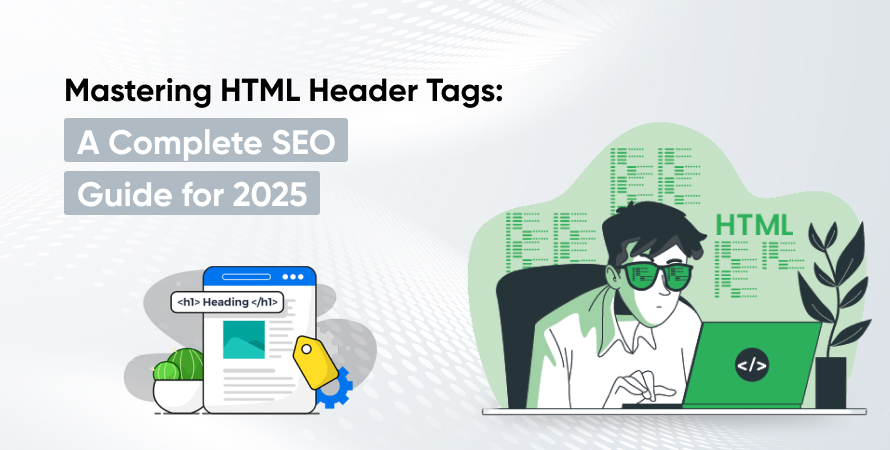Mastering HTML Header Tags: A Complete SEO Guide for 2025



At White Label SEO Providers, we know that agencies like yours are constantly seeking the edge that can make your clients’ websites rank higher, faster, and more sustainably. While strategies like backlinks and content marketing get the limelight, it’s the fundamental on-page SEO best practices that lay the groundwork for success. One such foundational yet often overlooked element? HTML header tags.
In this guide, we’ll break down what is a header, why header on HTML matters more than ever in 2025, and how your agency can master these tags to deliver superior SEO results to your clients.
What Are HTML Header Tags? (The Building Blocks of Web Hierarchy)
Let’s start at the core. HTML header tags are elements in the HTML for heading structure that define the headings and subheadings within a webpage. They range from H1 (the most important heading) to H6 (the least important). These tags don’t just format text—they signal to both users and search engines the structure and flow of your content.
Here’s a quick breakdown:
- H1: The main title or page header (only one per page)
- H2: Subsections of the H1 content
- H3-H6: Further nested details under H2s or lower headers
Example of header html structure:
<h1>Main Page Title (H1)</h1>
<h2>First Subheading (H2)</h2>
<h3>Supporting Detail (H3)</h3>
When used correctly, header tags offer clear semantic relevance—they help Google and users quickly understand what a page is about, how it’s structured, and which parts of the content matter most. This clear hierarchy is crucial when building comprehensive, crawlable, and user-friendly websites, especially as search engines grow smarter in interpreting SEO tags.
Why Header Tags Matter for SEO in 2025
The html header element isn’t just about design—it’s a critical component of technical SEO that speaks directly to search engines’ need for well-structured information. For agencies providing SEO services at scale, understanding this nuance is non-negotiable.
Here’s why:
- Google’s algorithm understands context through structure: The header of html guides crawlers through your content, much like chapter titles in a book.
- Enhances user experience (UX): Properly structured headers make long-form content scannable, reducing bounce rates and improving engagement signals.
- Improves semantic SEO: Search engines link header html with keyword relevance, topic authority, and content clarity—factors that play a direct role in rankings.
- Accessibility boost: Screen readers and assistive technologies rely on logical header flow to navigate pages, improving site accessibility and inclusivity.
For instance, agencies optimizing schema markup can enhance their strategies by first ensuring their clients’ html header tag structure is clean and logical. You can read more about schema strategies in our guide on Schema Markup for Local SEO.
In 2025, with Google’s EEAT framework (Experience, Expertise, Authoritativeness, Trustworthiness) in full swing, structured content is not just a nice-to-have—it’s a ranking factor that can distinguish your clients’ sites from competitors’.
Breakdown of Each Header Tag and Its SEO Role
Understanding the specific role of each header tag allows your agency to create precise, structured content for clients that search engines reward.
H1 Tag: The Page Title Powerhouse
The H1 tag acts as the headline of the entire webpage—it should clearly describe the primary topic of the page.
Best practices for agencies:
- Use exactly one H1 per page (it should reflect the page header or title).
- Align it with the primary keyword of the page.
- Make it compelling and descriptive but concise.
Example of an optimized H1 tag:
<h1>Comprehensive SEO Services for Local Businesses</h1>
While the meta title appears in search results, the H1 appears on the page itself—both should complement each other, not duplicate.
H2 Tags: Your Content’s Main Subtopics
H2 tags are ideal for breaking the content into meaningful sections, improving readability and guiding users through the page.
Best practices for agencies:
- Use H2s to define key subtopics or themes.
- Naturally incorporate secondary keywords (without stuffing).
- Ensure H2s accurately reflect the content that follows.
Example of an effective H2:
<h2>Why Local SEO Matters for Small Businesses</h2>
H3–H6 Tags: Layering Supporting Details
These tags are used for further subdivisions of content and are valuable when discussing lists, FAQs, or intricate subpoints.
Best practices for agencies:
- Use only when necessary to maintain clarity.
- Don’t force deeper levels if content is simple.
- Maintain a clean and readable structure.
Example of nested headers:
<h2>Our SEO Services</h2>
<h3>On-Page Optimization</h3>
<h3>Technical SEO Audits</h3>
By mastering this layered approach, your agency can ensure content not only ranks well but is engaging and easily digestible.
Best Practices for Using Header Tags (Actionable SEO Tips)
Here’s where execution matters most. As an agency, following these best practices ensures your clients’ sites are optimized to modern SEO best practices standards:
- Maintain a logical hierarchy- Always flow sequentially (H1 > H2 > H3), without skipping levels unnecessarily.
- Include keywords naturally- Use primary and secondary keywords within headers where contextually relevant, but avoid keyword stuffing at all costs.
- Keep headers concise and descriptive- A clear, punchy heading engages users and makes scanning easier.
- Enhance accessibility- Ensure screen readers can navigate the page smoothly using a structured html header element flow.
- Align with search intent- Headers should echo the queries your clients’ target audience is searching for.
- Implement semantic SEO structure- Use headers to support topic clusters that demonstrate expertise and authority—both critical elements of Google’s EEAT. (If you’re exploring ways to boost topical authority, you may also benefit from our insights on Choosing the Right White Label SEO Partner).
Example of optimized header flow:
<h1>Comprehensive Local SEO Solutions</h1>
<h2>Our Proven Strategies</h2>
<h3>Google Business Profile Optimization</h3>
<h3>Local Link Building</h3>
Common Mistakes to Avoid (And How to Fix Them)
Even experienced agencies can sometimes overlook header in HTML best practices. Missteps in structuring html headings can dilute SEO value and make content harder for both users and search engines to navigate. Let’s break down the pitfalls and the straightforward fixes your agency should implement for every client project.
Using Multiple H1 Tags Improperly
A common mistake is using multiple h1 header elements on a single page. While HTML5 technically allows more than one H1, it’s still best practice to stick to one clear, descriptive H1 to signal the primary topic to search engines. Confusing Google with multiple H1s can dilute html SEO clarity.
Fix: Always assign one distinct H1 per page and use H2s/H3s to divide subtopics.
Skipping Header Levels
Jumping from an H1 directly to an H3 (or beyond) can disrupt the logical flow of your html heading hierarchy. This can confuse crawlers and diminish content readability.
Fix: Maintain sequential structure—H1 > H2 > H3 and so on—to preserve semantic clarity.
Keyword Stuffing in Headers
Overloading header tag HTML elements with repetitive or unnatural keywords can trigger spam signals and reduce user trust.
Fix: Incorporate primary and secondary keywords naturally and contextually, ideally using synonyms and related terms.
Styling Text as Headers for Design Only
Using html headers purely for visual emphasis (rather than content structure) is a misuse of their function and can disrupt both accessibility and SEO HTML integrity.
Fix: Use CSS styling for design purposes and reserve heading tags strictly for content hierarchy.
Failing to Audit Existing Content
Many agencies overlook the importance of regularly auditing their clients’ websites for header structure issues. Tools like Screaming Frog or SEO Meta in 1 Click can help easily identify problems.
To scale content auditing alongside optimized header structures, you might want to explore our guide on Outsourcing Content Creation the Right Way — it’s designed to help agencies streamline their content workflows while upholding high technical SEO standards.
How Header Tags Enhance Featured Snippets & Voice Search
Modern SEO strategies aren’t just about ranking—they’re about visibility in rich features like Google Featured Snippets, People Also Ask boxes, and even voice search responses. Properly structured html header tags play a pivotal role here.
When your agency crafts clean html headings that directly answer specific user queries, it increases the chances of that content being pulled into featured snippets. For example:
<h2>What is Local SEO?</h2>
<p>Local SEO is the process of optimizing a business’s online presence to attract more customers from relevant local searches…</p>
This approach satisfies header tags SEO principles by aligning headings with clear, concise answers underneath.
Here’s why this works:
- Snippets prioritize clarity: Clean header HTML tag structures make it easier for Google to extract information.
- Voice search favors structured content: When a virtual assistant reads answers aloud, clear question-based headers improve selection chances.
- Improves topical authority: Structured sections demonstrate depth, a core part of Google’s EEAT expectations.
If your agency is aiming to build authority content around topic clusters, leveraging headers in this way pairs perfectly with strategies outlined in our Ultimate Content Creation Blueprint.
Expert Tips: Future-Proof Your Header Tags for SEO
Looking ahead, it’s clear that the agencies who master html header tags as part of holistic html SEO strategies will dominate SERPs. Here’s how your agency can stay ahead:
- Think in content clusters – Use html heading structures to build topic clusters around core themes. Each header should naturally lead to deeper, related content to boost topical authority.
- Optimize for conversational queries – Anticipate how people search verbally and structure headers around question-based formats (“What is X?”, “How does Y work?”).
- Combine with schema markup – Pair clean header HTML tag hierarchy with schema for maximum clarity to search engines. We’ve covered schema optimization strategies in detail here.
- Prioritize accessibility – Ensure screen readers and other assistive tools can easily navigate headers HTML by testing your pages regularly.
- Integrate with high-quality content – No amount of technical optimization can replace insightful, well-written content. To maintain quality at scale, many agencies are turning to Content Creation Services that blend SEO expertise with human creativity.
By embedding these practices into your workflows, your agency not only optimizes header tag HTML effectively but also builds stronger, more trusted client relationships. It’s a simple, scalable way to demonstrate experience, expertise, authority, and trust—the very foundation of lasting SEO success.
Conclusion
Mastering html header tags isn’t just about clean code—it’s about creating structured, scannable, and authoritative content that serves both search engines and users. For agencies serious about delivering measurable SEO results, refining your approach to header tags SEO is a strategic must.
At White Label SEO Providers, we’re committed to helping agencies like yours scale smarter and outperform competitors by mastering both fundamentals and advanced strategies. Whether it’s content creation, technical SEO, or white-label partnerships, we have your back.
Ready to take the next step? Explore how optimized content and scalable services can elevate your agency with our expert insights on Outsourcing Content Creation the Right Way.
Frequently Asked Questions (FAQs)
Header tags in HTML organize webpage content into a clear hierarchy, making it easier for search engines and users to understand key topics and subtopics. This improves crawlability, readability, and overall SEO performance.
A webpage should have only one H1 tag to clearly signal the primary topic of the page. Subsections should use H2 and H3 tags to maintain a logical structure.
Yes. Properly structured header tags can increase the chances of content being selected for featured snippets by presenting clear, concise answers under relevant headings.
Including relevant keywords naturally in header tags is recommended, but avoid keyword stuffing. Ensure the text remains helpful and contextually accurate.
Header tags break content into easily scannable sections, helping users quickly find the information they need, which reduces bounce rates and improves engagement.